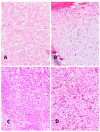Non-Coding RNAs in Diagnostic Pathology of High-Grade Central Osteosarcoma
- PMID: 40506925
- PMCID: PMC12154195
- DOI: 10.3390/diagnostics15111355
Non-Coding RNAs in Diagnostic Pathology of High-Grade Central Osteosarcoma
Abstract
A histological evaluation remains the cornerstone of diagnosing highly malignant osteosarcoma, having demonstrated its efficacy and reliability over several decades. However, despite these advancements, misdiagnoses with severe consequences, including inadequate surgical procedures, continue to occur. Consequently, there is a pressing need to further enhance diagnostic security. Adjunct immunohistochemical approaches have demonstrated significant effectiveness in regard to cancer diagnostics, generally. However, their utility for identifying highly malignant osteosarcoma is limited. Molecular genetic findings have significantly improved the diagnosis of Ewing's sarcoma by identifying specific translocations and have been used to detect specific IDH gene mutations in chondrosarcoma. Nevertheless, molecular genetic alterations in highly malignant osteosarcoma exhibit a high degree of complexity, thereby limiting their diagnostic utility. Given that only 1-2% of the human genome comprises protein-coding sequences, the growing number of non-coding regulatory RNAs, which are increasingly being elucidated, has garnered substantial attention in the field of clinical cancer diagnostics. Over the past several years, patterns of altered non-coding RNA expression have been identified that facilitate the distinction between benign and malignant tumors in various organs. In the field of bone tumors, the experience of this approach has been limited thus far. The divergent expression of microRNAs has demonstrated utility for differentiating osteosarcoma from osteoblastoma and discriminating between osteosarcoma and giant-cell tumors of bone and fibrous dysplasia. However, the application of non-coding RNA expression patterns for the differential diagnosis of osteosarcoma is still in its preliminary stages. This review provides an overview of the current status of non-coding RNAs in osteosarcoma diagnostics, in conjunction with a histological evaluation. The potential of this approach is discussed comprehensively.
Keywords: differential diagnosis; highly malignant osteosarcoma; non-coding RNAs.
Conflict of interest statement
The authors declare no conflict of interest.
Figures





References
-
- Nagano A., Matsumoto S., Kawai A., Okuma T., Hiraga H., Matsumoto Y., Nishida Y., Yonemoto T., Hosaka M., Takahashi M., et al. Osteosarcoma in patients over 50 years of age: Multi-institutional retrospective analysis of 104 patients. J. Orthop. Sci. 2020;25:319–323. doi: 10.1016/j.jos.2019.04.008. - DOI - PubMed
-
- Baumhoer D., Brunner P., Eppenberger-Castori S., Smida J., Nathrath M., Jundt G. Osteosarcomas of the jaws differ from their peripheral counterparts and require a distinct treatment approach. Experiences from the DOESAK Registry. Oral Oncol. 2014;50:147–153. doi: 10.1016/j.oraloncology.2013.10.017. - DOI - PubMed
Publication types
LinkOut - more resources
Full Text Sources
Miscellaneous

